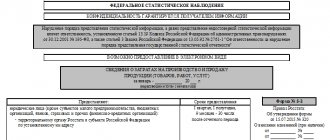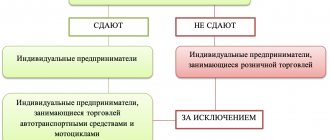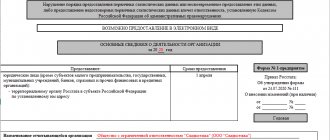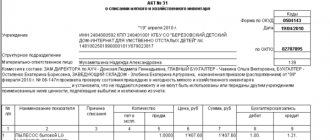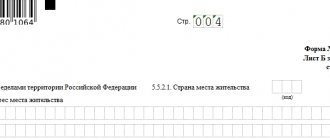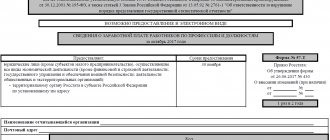When is the act drawn up in form N-1 and what information does it contain?
Form N-1 report is a mandatory element of the package of documents drawn up during the accident investigation process.
For more information about what documents are included in this package, see this material .
You will find a step-by-step algorithm for conducting an investigation of the National Assembly in the Guide from ConsultantPlus. A free trial of full access to the legal system is available.
The form of the report on an industrial accident was approved by Decree of the Ministry of Labor of Russia dated October 24, 2002 No. 73.
The information specified in the act can be divided into 3 blocks:
- initial data and information (about the victim, employer, composition of the NS investigation commission, etc.);
- description of the circumstances of the accident (including the type of incident, causes of the accident, witnesses, etc.);
- organizational and final block of information.
For details on filling out the two above blocks, see the material “Act on an accident at work (nuances)” .
In the following sections we will dwell in more detail on the nuances of the design of the organizational and final block of information.
Features of filling out the act
If an employee suffers an epileptic seizure while at work and is injured when he falls and hits the floor, then it is still necessary to file an Industrial Accident Report and investigate the incident as an industrial accident. This is the position taken by the regulatory authorities in their letters.
A report in Form N-1 must be drawn up in any case, regardless of the severity of the accident, as well as the number of persons involved. However, if it was a group case, or it led to serious injury or death, it is necessary to additionally draw up a report in Form 4.
Attention! If, based on the results of the investigation, it is established that both the employer (for example, did not provide protective equipment) and the employee (for example, behaved negligently) are to blame for the incident, then the degree of guilt of each is indicated as a percentage. This relationship is determined on the basis of data from a medical and social examination.
“Percentage” qualification of the degree of guilt of the victim
An important aspect when filling out the act f. N-1 - determining the degree of guilt of the victim if the insurance company is insured.
In Art. 229.2 of the Labor Code of the Russian Federation says the following about this. The degree of guilt of the insured (in%) is established by the investigation commission:
- when it is revealed that harm to the victim’s health has occurred or increased as a result of his gross negligence;
- taking into account the conclusion of the trade union (in certain cases, the state labor inspector who independently investigates the NS) or another body authorized by the employees.
The purpose of such a “percentage qualification” of the victim’s fault is the need to recalculate insurance payments intended to restore health if there was gross negligence on the part of the victim.
IMPORTANT! The amount of monthly insurance payments may be reduced (but not more than by 25%) depending on the degree of guilt of the insured (Article 14 of the Law “On Compulsory Social Insurance against Social Security at Work” dated July 24, 1998 No. 125-FZ).
The following must be taken into account:
- for those guilty of accidents, but not victims, the percentage is not established and insurance payments are not paid;
- in the event of the death of the victim, payments cannot be reduced;
- If the injury to health occurred due to the intent of the insured, which is confirmed by the conclusion of law enforcement agencies, compensation is not paid.
Thus, the amount of material compensation is directly dependent on the decision of the investigation commission on the degree of guilt of the victim. In this regard, the members of the commission have a responsible mission to correctly qualify the actions of the victim.
In particular, they must find out whether the victim’s actions were:
- haste;
- personal negligence;
- imprudence;
- disregard for personal safety;
- the result of fatigue (fatigue);
- uncoordinated actions;
- incorrect assessment of the situation, etc.
The above actions of the victim are considered in conjunction with the actions of the employer. The commission is obliged to establish whether the employer has done everything in his power to prevent NS, including:
- whether timely and high-quality training of the victim in safe work practices was carried out;
- whether he was provided with personal protective equipment;
- whether safe working conditions have been created;
- whether supervisory functions on labor safety issues have been performed by the company's responsible persons;
- what is the condition of the safety equipment (locking, fencing, etc.);
- do the provisions of the internal instructions on labor protection comply with the requirements of regulatory documents (GOSTs, federal and industry standards, etc.), etc.
Only after a high-quality and comprehensive investigation in the act f. N-1 the corresponding “percentage” entry is made.
Actions based on the results of the investigation
An employer that respects itself and its workforce carries out a regular set of measures aimed at preventing accidents. If labor safety issues in a company are resolved comprehensively and the employer does not skimp on the labor safety of its employees, accident situations become unlikely.
What points to pay attention to when organizing a labor protection system, read the article “Where to start labor protection at an enterprise (nuances)?”
If the accident did occur, when drawing up the act f. N-1 will have to fill out clause 11 “Measures to eliminate the causes of the accident, deadlines.”
This step in the overall scheme of investigating NS and filling out documentation has important preventive value. It allows:
- analyze the causes of the onset of NS;
- study in detail the effectiveness of the company’s occupational health and safety system;
- assess the competence of specialists responsible for occupational safety;
- determine measures to prevent accidents in the future.
The last of these points should be reflected in the act f. N-1. At the same time, the circumstances of the NS and the measures developed based on the results of the investigation must be interconnected. This will make it possible to build an effective mechanism for preventing (preventing) NS.
Requirements for the developed activities:
- relate to specific dates and responsible persons;
- comply with regulatory requirements in the field of labor protection;
- do not have vague formulations, expressing the planned measure concisely and using the necessary technical terminology.
A poor-quality or superficially conducted investigation, in turn, can lead to the fact that the true causes of NS are not identified and, accordingly, this will not lead to the development of measures that will truly eliminate the potential danger of relapse of NS.
The final part of the act form N-1
The last information block of the act of form N-1 includes the full names of the members of the commission who conducted the investigation of the NS, and the date of drawing up the act.
The commission is a mandatory and basic element in the NS investigation scheme. Its numerical composition and powers are determined by law.
The algorithm for forming a commission to investigate the National Assembly is regulated by Art. 229 Labor Code of the Russian Federation.
This article defines the following:
- the commission is formed by the employer (or his representative);
- number of commission members - at least 3 people;
- the composition of the investigation participants (commission members) is in relation to the type of emergency (according to the degree of harm caused to the victim’s health).
IMPORTANT! The differentiation of harm to health as a result of NS into severe and mild is made depending on the qualifying criteria specified in the order of the Ministry of Health and Social Development of Russia dated February 24, 2005 No. 160.
The composition of the commission is detailed as follows:
- subgroup “Minor harm to health” - the commission is headed by the employer (or his representative), the commission includes the specialist who decides labor safety issues in the company and a representative of the trade union;
- subgroup “Serious harm to health (including death)” - the commission is headed by a state labor inspector, who determines the composition of the commission, taking into account the legislative requirements and circumstances of the National Assembly;
- a representative of the FSS of Russia is included in the composition of the commission members (if the NS is an insurance company).
When forming the composition of the commission, it is necessary to observe the principles of rationality and objectivity: the absence of numerical and structural restrictions in the legislation does not mean the permissibility of an unreasonably inflated or reduced composition of the commission.
The structural parameters of the commission are determined by its chairman, taking into account the following nuances:
- it is inadmissible to reduce the size of the commission below 3 people;
- ensuring an odd number of commission members (to achieve objectivity in decisions);
- mandatory inclusion of legally defined specialists in the commission;
- distribution of responsibilities of each commission member;
- assessing the feasibility of including representatives of other services and departments (firefighters, power engineers, etc.) in the commission.
All members of the commission participating in the investigation are required to sign the act. Prior to putting a signature on the act, the quality work of the chairman in forming the composition of the commission and the performance by each of its members of a certain set of duties. We'll talk about this in the next section.
ConsultantPlus experts told us how to store investigation materials and how to keep records of accidents at work. Get trial access to the system for free and go to the K+ Guide:
Procedure for conducting an accident investigation
The investigation must be completed within 3 to 15 days. Depending on the injuries received by the employee.
In order to investigate the incident as objectively as possible, a commission (with a total composition of at least three people) must be created at the enterprise by a special order of the head, which may include employees from different departments and, necessarily, an occupational safety specialist.
The commission must be headed either by the head of the organization himself or his representative. If the accident had particularly serious consequences, then the commission may include employees of state regulatory authorities and representatives of the insurer.
Responsibilities of commission members before signing the act
Each NS is unique and unique in terms of the conditions and circumstances of its occurrence, causes, consequences and other nuances. All this imposes great responsibility on the members of the commission for a high-quality investigation of the National Assembly.
The distribution of responsibilities among the members of the commission rests with its chairman. Its competence includes organizing the work of the commission as a single mechanism in order to:
- all circumstances of the NS were established;
- reasons analyzed;
- the perpetrators have been identified;
- conclusions are formulated.
The entire set of duties of commission members during the investigation of the National Assembly can be combined into the following block:
- inspection of the scene of the incident (including using photo and video recording or other types of documentation);
- collecting information about accidents: interviewing eyewitnesses of accidents (if any) and victims (if possible);
- study of the level of organization of labor protection in the company: study of current regulatory documents and internal local acts that define the main aspects of the organization of labor protection (including the study of the scheme of responsibility for ensuring safe working conditions, determining the degree of guilt of officials, etc.);
- other duties determined by the chairman of the commission depending on the circumstances of the SB.
The detail of the actions of the commission members depends on the number of victims and the mechanisms and other technical means involved. The commission is personally obliged to inspect the following mandatory objects:
- structures, premises, vehicles where the accident occurred;
- mechanisms, materials, tools and devices and (or) other objects of labor that injured the victim;
- personal protective equipment used by the victim (to study their suitability and meet the conditions of compliance with regulatory requirements);
- safety equipment and protective devices.
The result of such an examination may serve as a basis for the commission to decide on the need for additional procedures. Eg:
- carrying out technical calculations;
- organization of tests and (or) laboratory research;
- attracting experts;
- other actions.
Each investigative procedure requires commission members to conscientiously perform their duties and be able to work as a team.
Where is the sample act of form N-1 and what to do if it is lost (lost)?
You can see and download a completed sample act of form N-1 on our website using the link below:
act form N-1 you can also:
- on the official website of the FSS in the section “Regulatory documents”;
- websites of territorial social insurance offices;
- in reference and legal systems.
Due to certain circumstances (fire, flooding, etc.), NS investigation documents may be lost partially or completely. This fact is regarded as the lack of objective confirmation of the fact of NS.
If such an incident affected the N-1 form, it is necessary to take certain steps to restore it. The procedure is described in the letter of the FSS of the Russian Federation dated June 28, 2005 No. 02-18/06-5771.
First of all, it is necessary to establish the fact of HC and properly qualify it.
To carry out the above actions:
- further investigation is underway;
- Based on its results, the state labor inspector issues a conclusion and an order to draw up an act on the NS.
At the same time, the lost and restored act on the Tax Code will not be completely identical due to the following circumstances:
- the signatures of the commission members are replaced with a record stating that the act was drawn up on the basis of the conclusion of the state labor inspector who conducted the investigation;
- Clause 8.2 of the report is filled in with information not only about the nature of the injuries received and the affected organ, but also about the health consequences that occurred at the time of the additional investigation.
An incident can only be declared an accident in court if, as a result of an additional investigation:
- the fact of NS is not confirmed;
- It is impossible to restore the act of form N-1.
When is it necessary to draw up a deed?
An N-1 form report is issued only if the incident is directly related to production. That is, the employee was injured during the production process and as a result he lost his ability to work. The list of situations that can be qualified as an industrial accident is given in Art. 227 Labor Code of the Russian Federation.
Some incidents are not related to production. However, they are also subject to investigation and recording. The only difference is in the documentation - such an act is drawn up in any form.
Results
Filling out the form N-1 report is carried out at the final stage of the work of the special commission to investigate NS in production.
The information reflected in the report should not only decipher the circumstances and causes of the accident, but also allow one to correctly determine the amount of insurance compensation (if the case is insured), as well as detail measures to prevent future repetition of industrial injuries.
Sources:
- Labor Code of the Russian Federation
- Federal Law of July 24, 1998 No. 125-FZ
- Resolution of the Ministry of Labor of Russia dated October 24, 2002 No. 73.
You can find more complete information on the topic in ConsultantPlus. Free trial access to the system for 2 days.
When is a report of an industrial accident drawn up?
If an accident occurs at an enterprise of any form of ownership, it is necessary to immediately draw up a corresponding report.
After the incident, the employer is obliged, on the basis of his order, on the same day to assemble a commission of an odd number of people, which conducts an investigation into the causes, circumstances and consequences of the accident. The commission includes members of the trade union, a labor protection specialist, a personnel and/or accounting department employee.
If there was a fatal injury, law enforcement representatives, insurance employees and inspectors are automatically included in the commission.
During the investigation, the commission is obliged to draw up an accident report.
The report is prepared simultaneously in several copies (at least three): one remains at the production site, the second is sent to the insurance service, the third is given to the injured person or his representative.
Copies are not copies: they must be compiled separately and contain the originals of all required personal signatures and seals.
If the incident occurred in a subject of the Russian Federation with two languages, each act must be drawn up in two copies - in the state language and in the language of the subject of the federation. Thus, the minimum number of copies can be increased to six units.
The commission's work period may be extended by 3-15 days, depending on the number of victims and the severity of the consequences for their health or life.
An accident report, regardless of the number of injured or killed, must be issued separately for each person.
It is filled out according to the standard form N-1, approved by Resolution of the Ministry of Labor No. 73 of October 24, 2002.
Each act is supported by a various documentary base: protocols for examining the scene of the incident, interviews with victims, eyewitnesses or officials. If necessary, notifications are sent to relatives of employees. The fact of the incident is recorded in the logbook.
The employer is obliged to undertake the organization and material costs of drawing up a medical report if a production employee dies or receives temporary disability for a period exceeding one day. In case of a group accident, a medical report must be issued separately for each employee.
If an employer fails to fulfill the obligation to notify emergency medical services in the event of a serious injury to employees, he faces criminal penalties.
How to fill out the N-1 form?
Filling out the N-1 act is the responsibility of the chief occupational safety specialist at the enterprise or the deputy head of the organization. In small companies, it is possible that the employer will have to prepare the documents independently.
Form N-1 must be filled out according to the following rules:
- In the upper part (“header”) you should indicate the “layout” of the document’s approval by the manager. This layout includes the name of the company, full name and position of the manager (director, general director, etc.) and the date of approval.
- The main part consists of 11 points, each of which carries certain information about the causes and results of the incident. These points will be described in more detail below.
- The manager’s signature and seal are placed at the very end and certify the authenticity of the document. Here you also need to provide the full names and signatures with a transcript of all persons participating in the investigation.
The main part is the largest and can include up to 70 pages with detailed descriptions of items and sub-items.
The items provide information about the incident:
- paragraph 1 – date and exact time (up to minutes) when the accident occurred;
- 2 – all information about the enterprise (name, address, activity codes), department where the victim worked;
- 3 – who sent the employee to the accident site and why;
- 4 – members of the commission assembled for the investigation;
- 5 – information (including biographical information) about a production employee who was injured during an unforeseen incident;
- 6 – similar information is indicated, but if the employee was sent on a business trip from another company or was a student or trainee;
- 7 – full description of the accident site (office, workshop, adjacent street area);
- 8 – description of the incident in verbal form from the words of the victim, his representatives or eyewitnesses;
- 9 – brief statement of the cause of the accident;
- 10 – the alleged culprits of the incident (if during the investigation it was possible to identify the suspects), here they indicate their full name, position, and length of service;
- 11 – conclusions recorded by the decision of the commission and the company management.
If confirmation of the presence of the act in the company is required for other authorities, copies can be made from the copy that remains stored at the enterprise and their authenticity can be certified by the signatures of the chief occupational safety specialist and the manager or his deputy.
and sample filling
.
.
